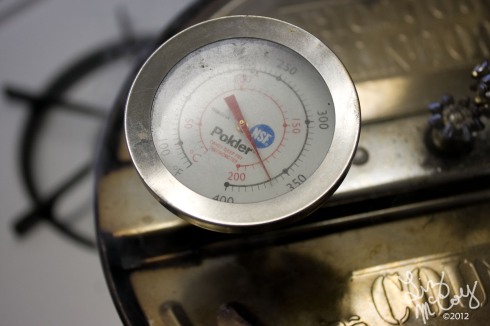This is part of a series on roasting your own coffee. Today’s post is the actual roast process. Do you have all of your equipment? If you missed the previous post about the supplies you’ll need, please read this post first.
When your popcorn popper has heated to 400 degrees (again, this is more difficult if your popper has not yet been seasoned), you want to add your green coffee beans at that point. Once you have done that, the temperature usually falls about 50 degrees. You will want it to hover around 350 for the duration of the roast process. Begin stirring (with the popper’s handle) immediately. You’ll need to continue constantly stirring during the entire process.
After about six minutes, the first signs of “first crack” will appear. You’ll actually hear the beans making a cracking sound. With some roasts, this may be barely audible. However, with some practice, you’ll begin to notice other signs of pending first crack. Once first crack occurs, second crack will not be far behind. I like to turn down the flame at this point so that I can control these events, because from here on out it begins to move more quickly. Once first crack has finished, the roast is said to be a “full city” roast. When the coffee beans start to sound like popcorn popping, you’re into “second crack”. Once second crack starts, I pour the coffee into the colander quickly. This is “full city +”, and is how I like most of my coffee, but depending on what the label on my bag of green coffee beans says, I sometimes vary this.
Once the coffee is in the colander, I usually take it outside, shaking it in the colander and blowing off the chaff. Chaff doesn’t really affect the taste of the coffee, but it makes a mess, so I just get rid of it. This also serves to cool the coffee down quickly. This is also important because the coffee will continue to roast if not cooled quickly.
If you prefer a darker roast, you can go on to French roast, which is what occurs after second crack is completely over. Go past French roast, and you’ll produce a coffee which tastes burnt and lacks body. I don’t recommend it.
Once your coffee has cooled enough to touch, remove any beans which are tan or white in color. You can also remove any beans which have gotten too dark for your liking. This ensures continuity of the cup.
Once you have roasted your coffee and gotten rid of the chaff and “quaker” (unroasted) beans, you’re ready to store your coffee. I store my coffee in a tin (which I am fairly certain is not made of tin). I do not completely seal the lid on it for 4 hours. This is also the amount of time it takes until the coffee reaches its “peak”. Freshly roasted coffee tastes much better after aging 4 hours. Since the biggest perk of roasting my own coffee is freshness, I do try not to roast more than what I can use in a few days to a week.
There are also a variety of coffee storage methods available in the same location I buy my coffee from : Sweet Marias. This website also has in-depth information about other roasting methods, such as using a wok or an air popper, all the way up fancy roasters specifically for the purpose of coffee roasting.
In my next installment, I’ll talk about how I brew my coffee to continue consistency in the cup.


